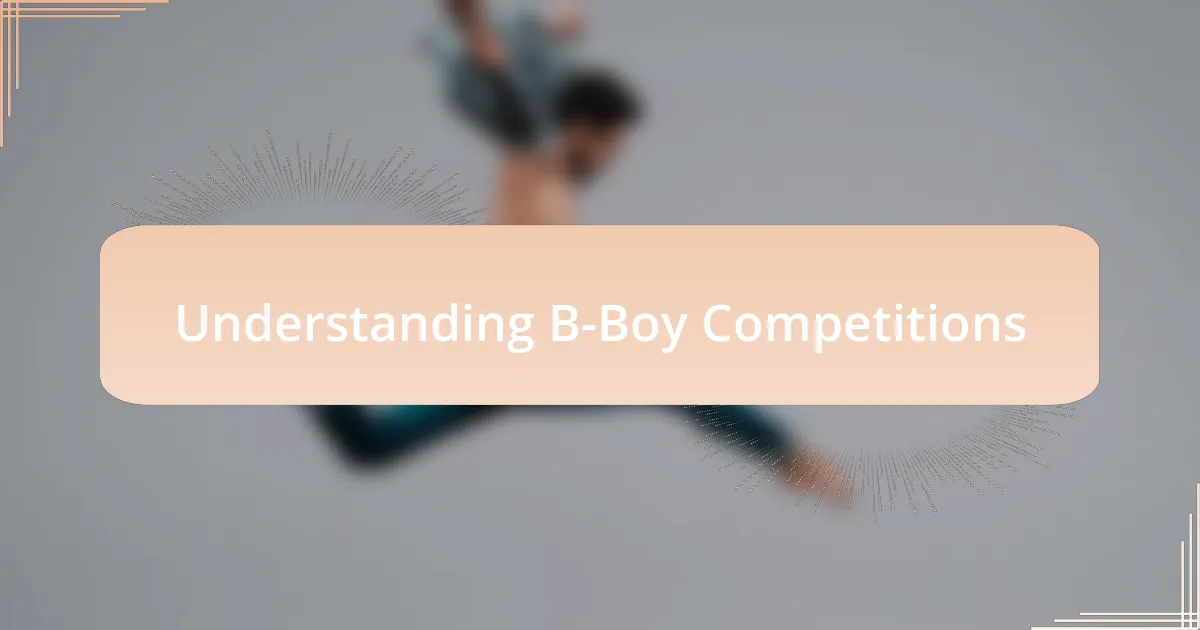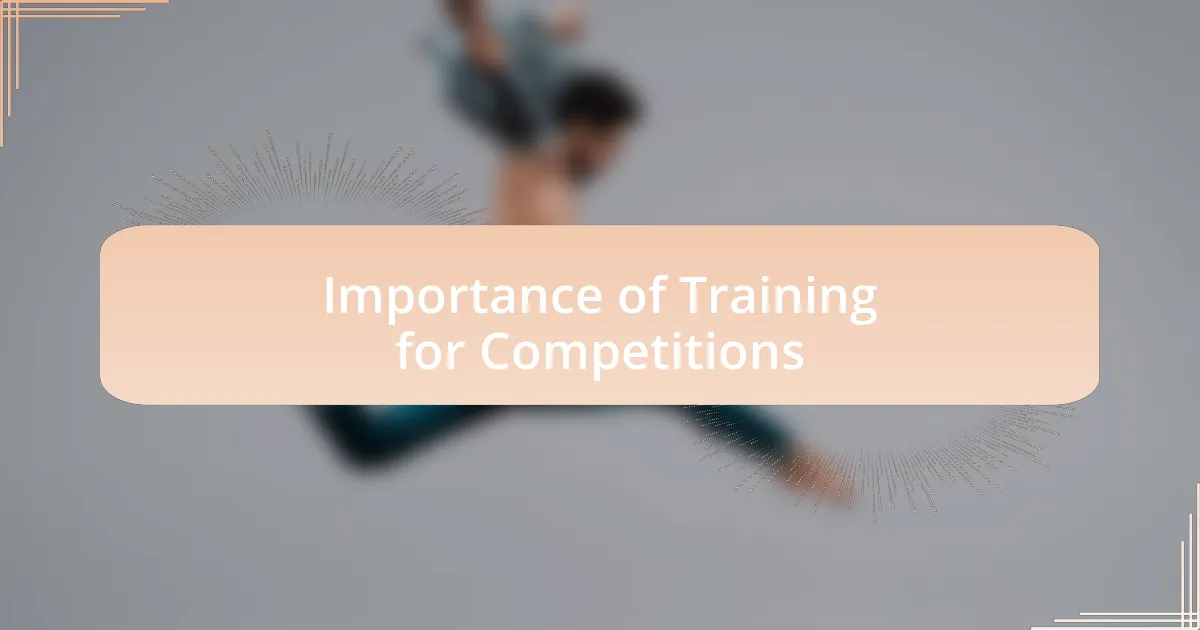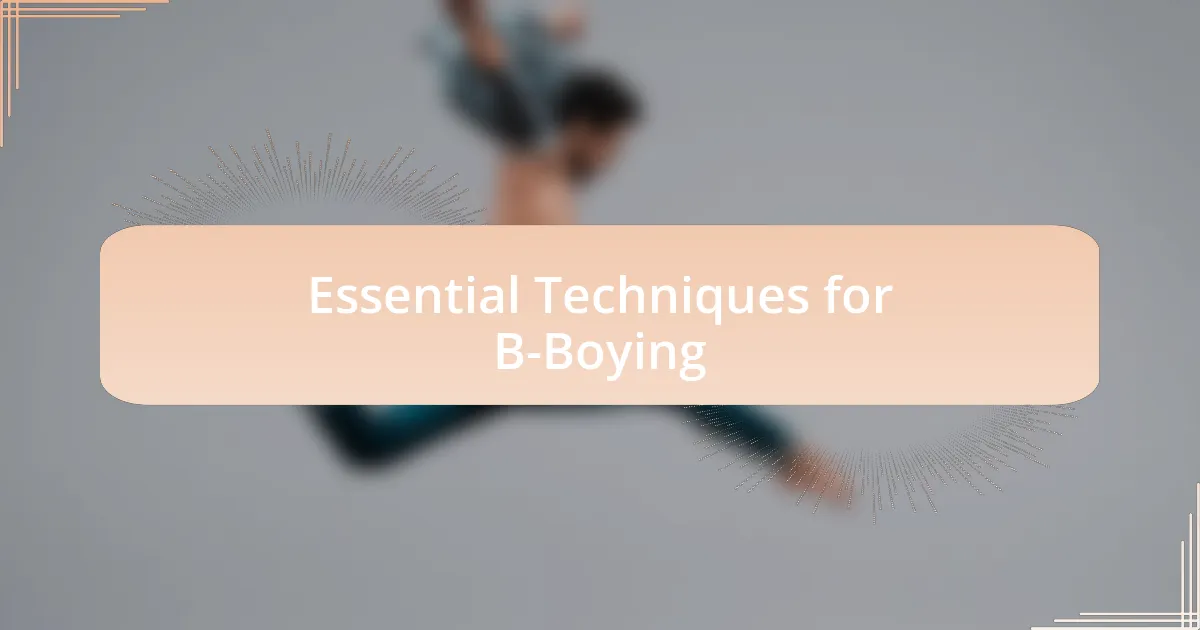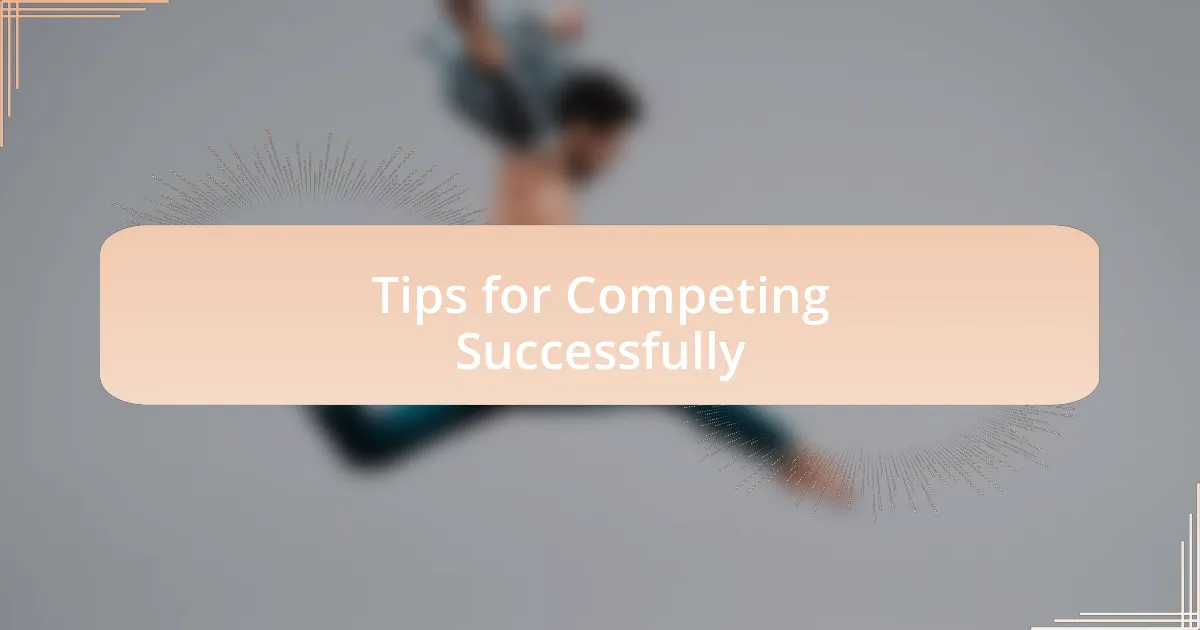Key takeaways:
- B-Boy competitions blend technical skill with creativity and personal expression, making training essential for performance and confidence.
- Develop a well-structured training schedule that balances power moves, footwork, and rest to optimize practice sessions.
- Incorporate both strength and flexibility training to enhance overall performance and prevent injury during challenges.
- Mental preparation, including visualization and understanding judges’ criteria, is crucial for success in competitions.

Understanding B-Boy Competitions
B-Boy competitions are not just about showcasing skills; they’re a celebration of culture, creativity, and community. When I first stepped into the battle arena, I felt a rush that was indescribable. The atmosphere was alive with energy and anticipation. Isn’t it fascinating how that shared passion can ignite such intense emotions among complete strangers?
At these events, each dancer tells a story through their moves, crafting a unique performance that reflects their personality and journey. I remember watching a fellow B-Boy pour his heart into every spin and freeze, and it was a reminder of how dance transcends mere physicality. How often do we find ourselves expressing what words cannot convey?
Ultimately, the competition is a dance of respect and rhythm, where judges evaluate not just technical skill, but also originality and stage presence. My own experience in battles has taught me the importance of creativity, as standing out often means taking risks. Have you ever thought about how stepping outside your comfort zone can lead to unforgettable moments on the dance floor?

Importance of Training for Competitions
Training for B-Boy competitions is absolutely essential because it directly impacts performance and confidence. I recall a time before a major competition when I focused on honing my transitions. The week leading up to the event, I practiced relentlessly, feeling the raw adrenaline each time I nailed a move. That preparation not only improved my technique but also gave me the mental edge I needed on the day of the competition. Have you ever noticed how a well-executed move can transform your entire routine?
Moreover, consistent training helps to build a deeper connection with the music and the dance. I remember when I dedicated a session purely to freestyling with my favorite beats. It opened up an avenue for creativity I hadn’t tapped into before. That experience showed me how important it is to train not just physically but also mentally, allowing the music to guide my movements. Doesn’t that blend of rhythm and skill create something truly special on stage?
Lastly, training in a competitive environment cultivates resilience and adaptability, qualities vital for any B-Boy. I’ve faced my share of setbacks, like failing to land a difficult freeze during practice. However, each failure taught me how to adapt my strategy for the next battle. In that sense, training isn’t just about physical preparation; it’s a journey of personal growth. Wouldn’t you agree that the struggles we face often lead to the most profound breakthroughs?

Essential Techniques for B-Boying
Essential Techniques for B-Boying
One of the fundamental techniques every B-Boy should master is the power move. I remember my early days, eagerly watching videos of legends effortlessly spinning and flipping. Learning the foundational spins, like the windmill and the flare, required countless hours of practice. The moment I first stuck a windmill felt monumental; it’s that feeling of achievement that fuels your passion, don’t you think?
Footwork is another critical aspect that can’t be overlooked. I found that breaking down complex footwork into smaller, manageable pieces made all the difference. Initially, I struggled with the six-step, but after focusing on each step separately, I began to connect them seamlessly. That transformation from confusion to fluidity was like unlocking a new level in a video game—did you ever have an experience where the pieces just clicked?
Finally, incorporating freezes into your routine adds a dramatic flair that judges love. I had a breakthrough moment with my freezes when I learned how to control my body weight effectively. As I held my pose in one intense competition, I could feel the crowd’s energy surge. There’s something magical about finding that balance between strength and artistry—how do you harness that in your own performance?

Designing a Training Schedule
Creating a training schedule for B-Boy competitions is a crucial step in honing your skills and maximizing your performance. I’ve always found that structuring my sessions around key techniques keeps me focused. For instance, I dedicate specific days to power moves, footwork, and freezes, ensuring that I give each aspect the attention it deserves.
Balancing practice with rest is just as essential. I recall a time when I pushed myself too hard, thinking more hours meant better results. Instead, I ended up fatigued and frustrated. By incorporating rest days and light sessions, I’ve managed to keep my energy levels high and my movements crisp. Have you noticed how a well-rested body performs at its peak?
Flexibility is vital when designing any training schedule. I often adjust mine based on how I’m feeling or if a particular technique needs extra work. Last month, I felt my footwork wasn’t up to par before a competition, so I shifted my focus for a week, allowing me to feel more confident on stage. Adapting your plan can make all the difference between a routine that feels forced and one that flows naturally—what changes have you made in your training schedule that positively impacted your performance?

Balancing Strength and Flexibility
When training for B-Boy competitions, I’ve learned that while strength is crucial for executing difficult moves, flexibility plays an equally important role. I distinctively remember the first time I attempted a power move without sufficient flexibility; the result was not only a strained muscle but also a hit to my confidence. Have you ever felt that frustrating disconnect during a performance? I realized that by dedicating time to stretches and mobility drills, I can push my physical limits safely and elevate my performance.
Incorporating a routine that enhances both strength and flexibility has become a game-changer in my training. A while back, I began to combine power-building exercises, like explosive push-ups, with deep stretches targeting my hips and shoulders. This approach allowed me to perform moves with greater ease. It’s fascinating how stretching doesn’t just feel good; it directly contributes to your strength by increasing your range of motion. How often do you find yourself willing to sacrifice one for the other?
I’ve found that the balance between strength and flexibility can change the nature of my practice. For instance, if I focus too heavily on strength one week, my flexibility tends to lag, making me feel stiff and limiting my creativity when freestyle dancing. That’s why I ensure my training includes a blend of both elements daily. Recognizing how each component influences the other can be insightful. Have you ever mapped out how your strength and flexibility complement each other?

My Personal Training Routine
In my personal training routine, I dedicate specific days to focus on different aspects of my skills. For example, I usually set aside Mondays and Thursdays for power moves, incorporating exercises like windmills and headspins. I remember the first time I successfully completed a headspin; the rush of adrenaline and pride was like nothing I had ever experienced. How often do you feel that thrill when mastering a new trick?
Alongside my strength training, I always prioritize skill drills, particularly for footwork and transitions. These practices consume at least 30 minutes each session, allowing me to refine my movements. I distinctly recall a period when I neglected this part of my routine, only to struggle during a battle because my transitions felt clunky. Have you ever faced a moment like that where you wished you had put in more effort during practice?
Additionally, recovery is a crucial component of my training routine. On weekends, I engage in yoga and foam rolling to promote muscle recovery and maintain flexibility. It’s during these sessions that I often reflect on how vital rest is to my overall performance. Have you found that taking time to recover can actually enhance your skills and prevent burnout in the long run?

Tips for Competing Successfully
When competing, mental preparation is just as important as physical training. I remember nerves creeping in before my first battle, making it difficult to focus. To combat this, I now visualize my performance beforehand. I picture each move and how the crowd will react, which calms my nerves and boosts my confidence. Have you ever tried visualization techniques to improve your mindset before a competition?
Another key aspect is understanding the judges’ criteria. I learned this the hard way after missing out on a win because my routine, while technically sound, lacked creativity. Since then, I’ve made it a point to incorporate unique elements and personal flair into my battles, ensuring I leave a lasting impression. What’s your strategy for standing out in a competition?
Lastly, engaging with fellow competitors can offer unexpected insights. I often chat with other B-Boys after battles, sharing techniques and tips that have helped me elevate my skills. These conversations not only build camaraderie but also inspire new ideas for my routines. Have you connected with other dancers to exchange knowledge, and how has that impacted your growth in the scene?